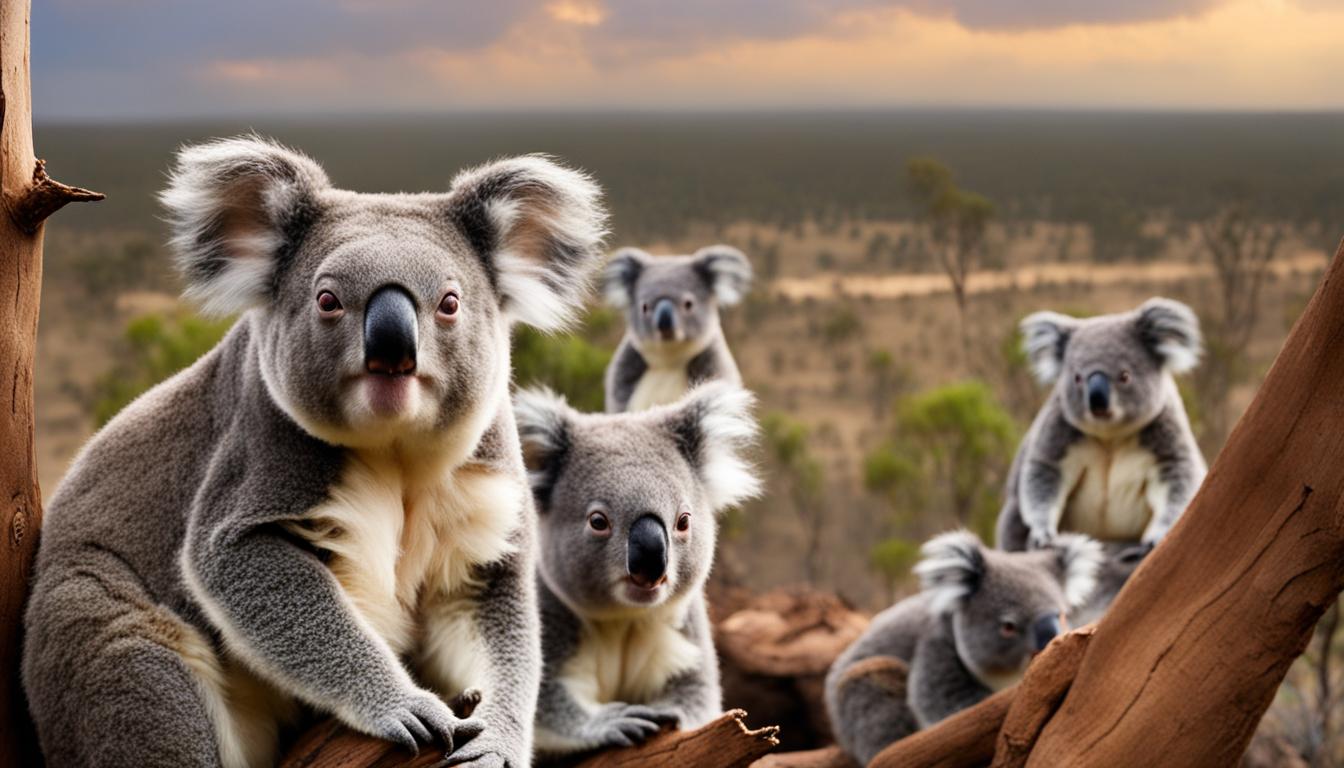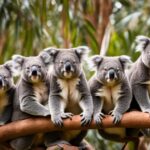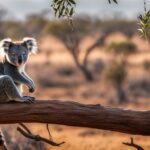Welcome to our article on the impact of human-koala conflicts on koala populations. In this section, we will explore the various ways in which human activities affect these adorable marsupials and the importance of koala conservation.
Since Europeans settled in Australia, human actions such as land clearing for agriculture, housing, mining, and roads have destroyed more than four-fifths of the original koala habitat. This loss of habitat poses a significant threat to wild koala populations.
Human impacts on koalas extend beyond habitat destruction. Increased disturbance by humans, injury or death from traffic and domestic animals, effects of garden pesticides, competition for food and territory, and increased stress leading to disease all contribute to the decline of koalas in the wild.
In the upcoming sections, we will delve deeper into specific aspects of human impacts on koala populations, including the effects of habitat loss, the consequences of bushfires and disease outbreaks, and the need for conservation efforts to protect these beloved creatures.
The impact of habitat loss on koala populations
The destruction of koala habitat has had a devastating effect on their populations. With more than four-fifths of their original habitat destroyed, primarily due to human activities such as agriculture, housing, and infrastructure development, koalas are facing immense challenges in their survival. The loss of their natural habitat disrupts their way of life and exposes them to numerous threats.
One of the most immediate consequences of habitat loss is increased disturbance. As koalas are forced to navigate through fragmented and developed areas, they become more susceptible to human activities that can cause injury or death. Road accidents and dog attacks are a significant risk for koalas as they venture into urbanized regions in search of food and shelter.
Habitat loss also leads to increased competition for food and territory among koalas. With their habitat shrinking, koalas have to contend with limited resources, making it harder for them to find suitable food and establish their territories. This competition can exacerbate stress levels, weakening their immune systems and making them more vulnerable to diseases like chlamydia.
| Effects of Habitat Loss on Koala Populations | Summary |
|---|---|
| Increased disturbance by humans | Increased risk of injury or death |
| Competition for food and territory | Limited resources, stress, and vulnerability to disease |
| Exposure to diseases | Chlamydia and weakened immune systems |
“The loss of koala habitat due to human activities directly impacts their population decline. It disrupts their way of life, exposes them to increased disturbance, competition, and disease, making their survival an uphill battle.”
It is clear that habitat loss is a significant factor in the decline of koala populations. To protect these iconic marsupials and reverse their dwindling numbers, it is crucial to prioritize habitat preservation efforts. By preserving and restoring their natural habitat, implementing sustainable land-use practices, and reducing human-wildlife conflicts, we can help ensure a brighter future for koalas.
Human Impacts on Koala Populations
The interaction between humans and koalas has a direct and significant impact on the population of these beloved marsupials. Human-wildlife conflict, particularly the destruction and fragmentation of koala habitat, poses a threat to their survival. Urbanization and land clearing for development have resulted in the loss of vast koala habitats, forcing them to navigate through human-dominated areas.
This increased exposure to human activities puts koalas at risk of road accidents and dog attacks, leading to injury or death. The growing human population and the need for housing further exacerbate the pressure on remaining koala habitats, leaving them with limited resources and territory for survival.
To mitigate human impacts on koala populations, it is crucial to prioritize habitat preservation and restoration efforts. Implementing sustainable land-use practices can help ensure the availability of suitable habitats for koalas while minimizing conflicts with human activities. Creating wildlife corridors that connect fragmented habitats can also aid in reducing human-wildlife conflicts and promoting koala conservation.
Furthermore, enforcing regulations to protect koalas from vehicle collisions and dog attacks can significantly contribute to their population’s well-being. By raising awareness about the importance of coexisting with koalas and taking proactive measures to mitigate human impacts, we can help safeguard the future of these iconic Australian creatures.

Mitigating Koala-Human Conflicts
Efforts to mitigate koala-human conflicts involve a multi-faceted approach that requires collaboration between various stakeholders, including government bodies, conservation organizations, and local communities. Some key strategies for mitigating koala-human conflicts include:
- Implementing strict land-use regulations to protect koala habitats from encroachment and development.
- Creating and maintaining wildlife corridors to facilitate koala movement between fragmented habitats.
- Developing educational programs to raise awareness among the public about the importance of conserving koala populations.
- Supporting research and monitoring initiatives to better understand the ecological needs and vulnerabilities of koalas.
- Collaborating with landowners and local communities to implement sustainable land management practices that prioritize wildlife conservation.
By taking these proactive measures, we can strive to create a harmonious coexistence between humans and koalas, ensuring the long-term survival and well-being of these iconic Australian animals.
The Effects of Bushfires and Disease on Koala Populations
Koala populations face significant threats from bushfires and diseases, which have contributed to their decline in recent years. Bushfires, especially when they occur in areas surrounded by human development, can have devastating consequences for koalas. These fires can completely wipe out entire colonies of koalas in a single event, destroying their habitat and leaving them vulnerable to injury or death. The aftermath of a bushfire also leads to a scarcity of food and shelter, further impacting their survival.
Koalas are also susceptible to various diseases, with chlamydia being a particularly prevalent and harmful infection. Chlamydia affects almost all koalas in certain regions and weakens their immune systems, making them more susceptible to other diseases as well. Disease outbreaks, combined with the stress caused by habitat loss and human-wildlife conflicts, have exacerbated the decline in koala populations.
The combination of bushfires and diseases poses a grave threat to the survival of koalas in the wild. Efforts to protect and conserve koala populations must include measures to prevent and manage bushfires effectively, as well as initiatives to minimize the spread of diseases among koalas. Additionally, the preservation and restoration of their natural habitat are crucial in providing them with the resources they need to thrive and recover.
The Impact of Bushfires and Disease on Koala Populations
Table: Comparison of the impact of bushfires and disease on koala populations
| Bushfires | Disease | |
|---|---|---|
| Extent of Impact | Can wipe out entire colonies in a single event | Prevalent in almost all koalas in certain regions |
| Consequences | Destroys habitat, leads to injury or death | Weakens immune systems, increases vulnerability to other diseases |
| Contributing Factors | Occur in areas surrounded by human development | Stress from habitat loss and human-wildlife conflicts |
| Management | Effective prevention and response strategies | Disease monitoring and treatment programs |
Conclusion
Human-koala conflicts, such as habitat loss, road accidents, dog attacks, and disease outbreaks, have had a detrimental impact on koala populations. To protect these adorable creatures, it is vital to prioritize koala conservation efforts.
Preserving and restoring their natural habitat is crucial for safeguarding the future of koalas. By implementing measures to reduce human-wildlife conflicts, advocating for sustainable land-use practices, and raising awareness about the importance of koala conservation, we can make a significant difference in protecting koala populations.
Koalas are facing a population decline, and it is up to us to take proactive steps to ensure their survival. Through our collective efforts, we can ensure that these unique marsupials continue to thrive for generations to come.
FAQ
How do human activities impact koala populations?
Human activities such as habitat destruction, road accidents, dog attacks, and disease outbreaks have a detrimental impact on koala populations. These activities contribute to the decline of koalas in the wild.
What is the main threat to wild koala populations?
The main threat to wild koala populations is the loss of habitat. More than four-fifths of the original koala habitat has been destroyed due to human activities such as land clearing for agriculture, housing, mining, and roads.
How can we mitigate human-koala conflicts?
To mitigate human-koala conflicts, it is crucial to prioritize habitat preservation, implement sustainable land-use practices, consider wildlife corridors, and enforce regulations to protect koalas from vehicle collisions and dog attacks.
What are the effects of bushfires and diseases on koala populations?
Bushfires pose a significant threat to koala populations, wiping out entire colonies in a single event. Additionally, diseases like chlamydia, exacerbated by habitat loss and stress, contribute to the decline in koala numbers.
How can we protect and conserve koala populations?
To protect and conserve koalas, it is important to prioritize koala conservation efforts. This includes preserving and restoring their natural habitat, implementing measures to reduce human-wildlife conflicts, advocating for sustainable land-use practices, and raising awareness about the importance of koala conservation.










